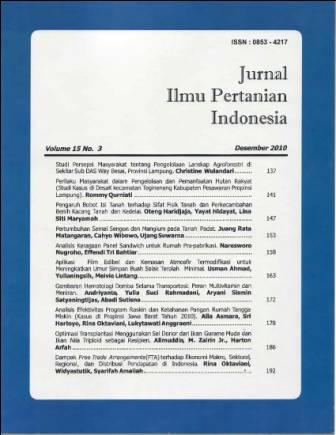Analisis Efektivitas Program Raskin dan Ketahanan Pangan Rumah Tangga Miskin “Kasus Di Propinsi Jawa Barat Tahun 2010”
Abstract
Realizing that there are still alot of poor households (RTM) in Indonesia, the government through various programs and policies continue to improve the food security conditions of poor households, particularly through Raskin. The implementation of Raskinhas been running about ten years. However, the criteria of “Enam Tepat” as indicator of success oof Raskin, has not been fully achieved. The purpose of this study consist of: Firstly, analyze the effectiveness of the Raskin program in West Java. Secondly, analyze the condition of the food security of poor households in West Java. The study was designed as a research survey with the simple random sampling method.The results showed that the actual Raskin recipients exceed the amount of targeted households (RTS) with deviations ranging from 17.33 to 164.23 percent. Deviation in the quantity indicator ranged from 14.77 to 62.15 per cent. While, the price deviations ranged from 14.26 to 40.19 per cent. For timely indicators of Raskinis generally achieved. Analysis on food security conditions of poor households showthat the poor households that categorized as vulnerable on food is approximately 6.7 percent to 34.5 percent.
Downloads
References
Azwar, A. 2004. Aspek Kesehatan dan Gizi dalam Ketahanan Pangan. Dalam: Prosiding Widyakarya Nasional Pangan dan Gizi VIII “Ketahanan Pangan dan Gizi di Era Otonomi Daerah dan Globalisasi”. BPS, Departemen Kesehatan, Badan POM, Bappenas, Departemen Pertanian dan Ristek, Jakarta.
Boudreau, E.T. and Dilley M. 2001. Coming to Terms with Vulnerability: a Critique of the Food Security Definition. Food Policy 26 pp 229–247.
Departemen Dalam Negeri. 2006. Pedoman Umum Program Untuk Keluarga Miskin (Raskin). Tahun 2006. Jakarta
Ilham, N dan Sinaga, B.M. 2009. Penggunaan Pangsa Pengeluaran Pangan Sebagai Indikator Ketahanan Pangan.
Maxwell, S. 1996. Food Security: a Post-Modern Perspective. Food Policy, Vol. 21. No. 2.
Maxwell, S. and Slater, R. 2003. Food Policy Old and New. Development Policy Review, Vol. 21(5-6).
Pakpahan, Saliem, Suhartini dan Syafa’at. 1993. Perkembangan Keanekaragaman Konsumsi Pangan Rumah Tangga Kota di Indonesia. Forum Statistik No.3 Tahun IX. 9-24.
Purwantini, H., Rachman dan Marisa. 2005. Prospek Diversifikasi Usaha Rumah Tangga Dalam Mendukung Ketahanan Pangan dan Penanggulangan Kemiskinan. Forum Penelitian Agro Ekonomi. Vol. 24, No.1 Juli, 2006. 1-13. Pusat Penelitian dan Pengembangan Sosial Ekonomi Pertanian. Bogor
R. Tabor dan M. Sawit. 2001. Social Protection via Rice: The OPK Rice Subsidy Program in Indonesia Developing Economies 39: 3 267 - 94
Saliem, H.P.,M. Ariani, Y. Marisa dan T.B.Purwantini. 2002. Analisis Kerawanan Pangan Wilayah Dalam Perspektif Desentralisasi Pembangunan. Laporan Hasil Penelitian. Pusat Penelitian dan Pengembangan Sosial Ekonomi Pertanian. Bogor
Sage, C. 2002. Food Security and Environment. Cheltenham: Edward Elgar.
Sawit, M.H. dan M. Ariani. 1997. Ketahanan Pangan : Konsep, Kebijaksanaan dan Pelaksanaannya. Makalah disampaikan pada Seminar Pra-WKNPG VI, Bulog, Jakarta 26 – 27 Juni.
Sawit, H. 2002. RASKIN: Sebuah Program Perlindungan Sosial, Majalah Pangan, No. 38/XI/Januari/2002
Sen, A. 1981. Poverty and Famines: An Essay on Entitlement and Deprivation. Oxford, Clarendon Press.
Suhardjo. 1996. Pengertian dan Kerangka Pikir Ketahanan Pangan Rumah Tangga. Makalah disampaikan pada Lokakarya Ketahanan Pangan Rumah Tangga, 20 – 30 Mei 1996, Yogyakarta.
This journal is published under the terms of the Creative Commons Attribution-NonCommercial 4.0 International License. Authors who publish with this journal agree to the following terms: Authors retain copyright and grant the journal right of first publication with the work simultaneously licensed under a Creative Commons Attribution-NonCommercial 4.0 International License. Attribution — You must give appropriate credit, provide a link to the license, and indicate if changes were made. You may do so in any reasonable manner, but not in any way that suggests the licensor endorses you or your use. NonCommercial — You may not use the material for commercial purposes.



















